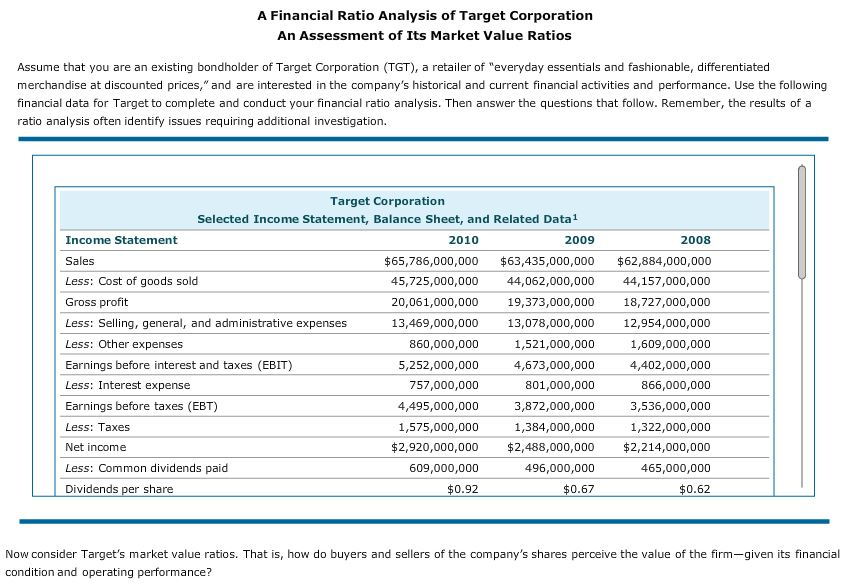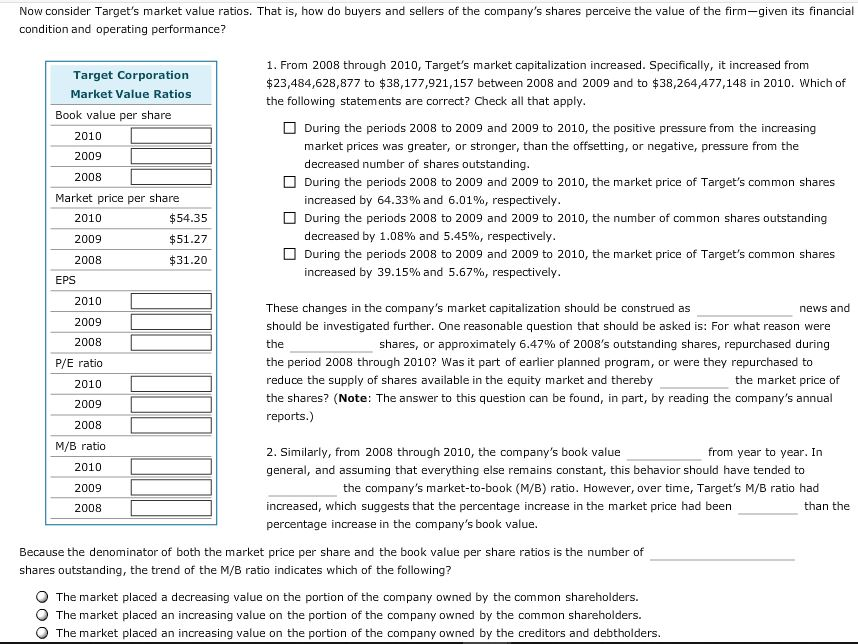


A Financial Ratio Analysis of Target Corporation An Assessment of Its Market Value Ratios Assume that you are an existing bondholder of Target Corporation (TGT), a retailer of "everyday essentials and fashionable, differentiated merchandise at discounted prices, and are interested in the company's historical and current financial activities and performance. Use the following financial data for Target to complete and conduct your financial ratio analysis. Then answer the questions that follow. Remember, the results of a ratio analysis often identify issues requiring additional nvestigation. Target Corporation Selected Income Statement, Balance Sheet, and Related Data1 Income Statement Sales Less: Cost of goods sold Gross profit Less: Selling, general, and administrative expenses Less: Other expenses Earnings before interest and taxes (EBIT) Less: Interest expense Earnings before taxes (EBT) Less: Taxes Net income Less: Common dividends paid Dividends per share 2008 $65,786,000,000 $63,435,000,000 $62,884,000,000 44,157,000,000 18,727,000,000 12,954,000,000 1,609,000,000 4,402,000,000 866,000,000 3,536,000,000 1,322,000,000 2010 2009 45,725,000,000 20,061,000,000 13,469,000,000 860,000,000 5,252,000,000 757,000,000 4,495,000,000 1,575,000,000 44,062,000,000 19,373,000,000 13,078,000,000 1,521,000,000 4,673,000,000 801,000,000 3,872,000,000 1,384,000,000 $2,920,000,000 $2,488,000,000 $2,214,000,000 609,000,000 496,000,000 465,000,000 0.92 0.67 0.62 Now consider Target's market value ratios. That is, how do buyers and sellers of the company's shares perceive the value of the firm-given its financial condition and operating performance? Now consider Target's market value ratios. That is, how do buyers and sellers of the company's shares perceive the value of the firm-given its financial condition and operating performance? Target Corporation Market Value Ratios 1. From 2008 through 2010, Target's market capitalization increased. Specifically, it increased from $23,484,628,877 to 38,177,921,157 between 2008 and 2009 and to $38,264,477,148 in 2010, which of the following statements are correct? Check all that apply Book value per share During the periods 2008 to 2009 and 2009 to 2010, the positive pressure from the increasing market prices was greater, or stronger, than the offsetting, or negative, pressure from the decreased number of shares outstanding During the periods 2008 to 2009 and 2009 to 2010, the market price of Target's common shares increased by 64.33% and 6.01%, respectively During the periods 2008 to 2009 and 2009 to 2010, the number of common shares outstanding decreased by 1.08% and 5.45%, respectively During the periods 2008 to 2009 and 2009 to 2010, the market price of Target's common shares increased by 39.15% and 5.67%, respectively 2010 2009 2008 Market price per share 2010 2009 2008 $54.35 $51.27 $31.20 EPS 2010 2009 2008 P/E ratio 2010 2009 2008 M/B ratio 2010 2009 2008 These changes in the company's market capitalization should be construed as should be investigated further. One reasonable question that should be asked is: For what reason were the the period 2008 through 2010? Was it part of earlier planned program, or were they repurchased to reduce the supply of shares available in the equity market and thereby the shares? (Note: The answer to this question can be found, in part, by reading the company's annual reports.) news and shares, or approximately 6.47% of 2008's outstanding shares, repurchased during the market price of 2. Similarly, from 2008 through 2010, the company's book value general, and assuming that everything else remains constant, this behavior should have tended to the company's market-to-book (M/B) ratio. However, over time, Target's M/B ratio had th comanys aiet-t mhavor sho.ufim year to increased, which suggests that the percentage increase in the market price had been percentage increase in the company's book value. than the Because the denominator of both the market price per share and the book value per share ratios is the number of shares outstanding, the trend of the M/B ratio indicates which of the following? O The market placed a decreasing value on the portion of the company owned by the common shareholders. O The market placed an increasing value on the portion of the company owned by the common shareholders. O The market placed an increasing value on the portion of the company owned by the creditors and debtholders 3. Target's earnings per share (EPS) ratio, which is calculated by dividing its exhibited a consistently increasing trend, growing by by the number of common shares outstanding, between 2008 and 2009 and by between 2009 and 2010. 4. From 2008 through 2010, Target's price-to-earnings (P/E) ratio exhibited an inconsistent trend. Which of the following phenomena contributed to this pattern? Check all that apply Between 2009 and 2010, the market price per share of Target's common stock increased by a greater percentage than that exhibited by its EPS Between 2008 and 2009, the market price per share of Target's common stock increased by a greater percentage than that exhibited by its EPS Between 2008 and 2009, Target's EPS increased by a greater percentage than the market price of its common shares









